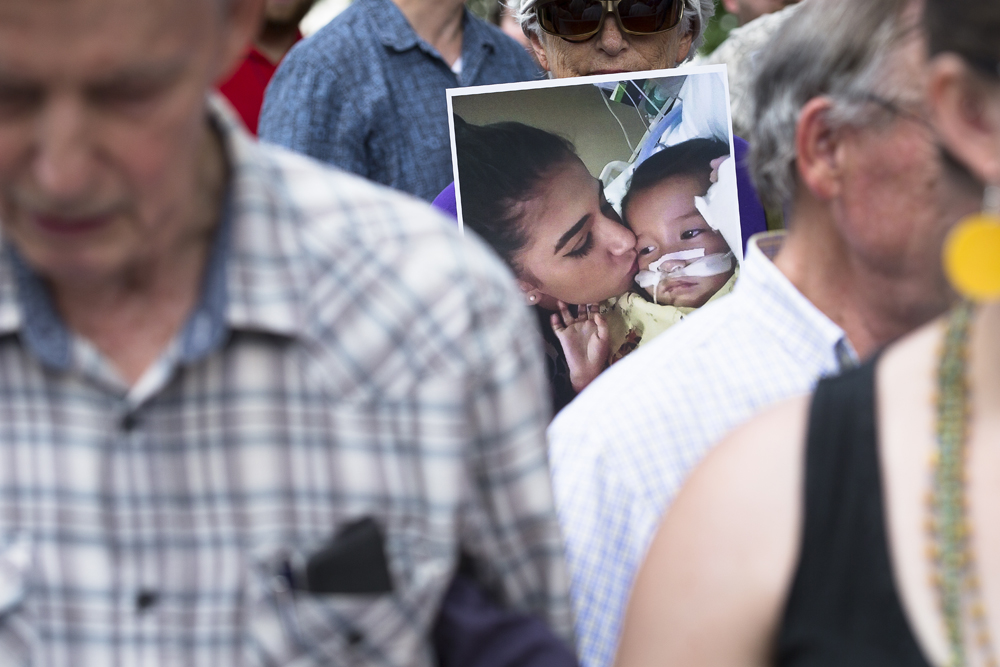
Catholic leaders and advocates protest the Trump administration's handling of detained immigrant children during a "Catholic Day of Action for Immigrant Children" July 18, near the U.S. Capitol in Washington. (CNS/Tyler Orsburn)
The situation on the southern borders of the United States is disgraceful. In Texas alone, some 16,000 persons jam detention centers, hoping for asylum. Most are Mexicans, joined by persons from El Salvador, Honduras and Guatemala.
They came in hope. They may be sent back.
What is going on?
To begin with, the U.S. uses two different terms: immigrants either immediately or down the line found to be illegal are "returned" or "removed." That is: either leave, or Immigration and Customs Enforcement will take you back. No matter what you call it, it's still deportation.
The law restricts immigration. Like it or not, the Executive Branch must enforce immigration laws. That would be the president. Every president.
In 2000, President Bill Clinton presided over the most deportations in U.S. history, when some 1,860,000 people were either returned or removed. Department of Homeland Security statistics show drastically smaller numbers for 2016 (440,065 under President Obama) and 2017 (396,118 under President Trump).
Second, both Presidents Obama and Trump have tried and failed to change immigration laws. Obama failed against a Republican Congress, Trump is failing against a Democratic Congress.
Third, more people are coming, and fewer are granted asylum. Hence the news reports, general uproar, and ensuing acts of civil disobedience. Seven minor children died in inadequate border detention centers; U.S. Capitol Rotunda police arrested 70 Catholic activists praying and protesting those conditions and those deaths.
Why is this happening? Isn't the U.S. a nation of immigrants?
To begin with, consider the question of boundaries. Psychologists say individuals must establish and maintain boundaries — the physical, mental and emotional borders others may not cross.
Are borders legitimate national boundaries? Who sets borders? And who sets the rules for crossing them?
In the U.S., the Congress makes the laws, and the Executive Branch enforces them. Today, the combination of enforcing laws and refusing to change them creates the current mess. Groups of individuals, like the arrested Catholic activists, shed light on this congressional-presidential train wreck.
So, we are back to square one, all the while separating families and scaring the resident immigrant population to death.
U.S. restrictions on immigration are not new. Ellis Island served as a major immigration center in the 19th and 20th centuries, in many respects just as inadequate as today's Texas border facilities. Then, as now, people kept coming, more than Ellis Island could handle. Too many people, too little space was the argument. So, the Emergency Immigration Act of 1921 (restricting Southern and Eastern European immigration) and the Immigration Act of 1924 (restricting Asian immigration) put a damper on all that.
Was it really about space? Who could come? Well, folks like "us." Not Italians, not Jews, not Chinese. Unacceptable immigrants were either dark-skinned or "yellow." Acceptable immigrants came speaking English, from the "right" countries, professing the "right" religions. (Remember the signs: "no Irish need apply"?)
Advertisement
Those were racist boundaries. Potential Americans barred before they arrived were not judged on brains or ability. They were eliminated by ethnicity and/or religious belief.
Which brings us back to the U.S.'s southern border, packed with brown-skinned, Spanish-speaking, mostly Christian immigrants, members of the planet's army of displaced persons. They walked or rode or swam to the U.S., and now hope to explain they are at the mercy of drug lords, corrupt governments, gang wars, and abject poverty. They cannot eat, they cannot sleep, they cannot work where they were born, and so they followed the star to Texas or Arizona where they sit owning nothing but hope.
They are not alone. In June 2019, the United Nations counted 70.8 million displaced persons at the end of 2018, among them 3.5 million asylum-seekers. Conflict and persecution alone displace 37,000 people every day.
Some say the cause is broken economics, some say it is broken governments. The U.S. in years past tried to address each for its southern neighbors and may continue to do so. But meanwhile, being a little more flexible with boundaries and borders would ease a lot of human suffering.
[Phyllis Zagano is senior research associate-in-residence at Hofstra University in Hempstead, New York. She will speak Friday, Sept. 13 at the Bishop Keane Institute of Immaculate Conception Church in Hampton, Virginia and Tuesday, Sept. 24 at the Boisi Center for Religion and American Public Life at Boston College. Her books include Women Deacons: Past, Present, Future, recently published in France and Canada as Des femmes diacres and in Portugal as Mulheres diáconos: Passado, presente, futuro. Study guides are available for free download at people.hofstra.edu/Phyllis_Zagano.]
Editor's note: We can send you an email alert every time Phyllis Zagano's column, Just Catholic, is posted. Click here to sign up for email alerts.






